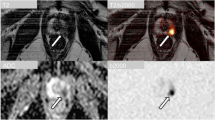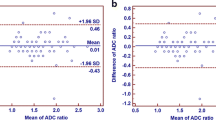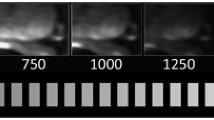Abstract
Purpose
To compare advanced non-parallel transmission zoomed diffusion-weighted imaging (nonPTX zoom-DWI) to conventional DWI (conv-DWI) for the assessment of prostate cancer (PCa).
Methods
This retrospective study included 98 patients who underwent conv-DWI, nonPTX zoom-DWI, and T2-weighted imaging of the prostate. The image qualities of the two DWI sets, including the distortion of the prostate and the existence of artifacts, were evaluated. To compare the overall PCa and clinically important PCa (ciPCa) detection ability between the sets, lesions were scored using the Prostate Imaging Reporting and Data System (PI-RADS) version 2. Apparent diffusion coefficient (ADC) values of the lesions were also measured and compared. The Mann–Whitney U test was used to compare continuous variables, and the χ2 test was used to compare categorical variables. Two-sided P values of < 0.05 were considered significant.
Results
Non-PTX zoom-DWI yielded significantly better image quality and image analysis reproducibility than conv-DWI (all P < 0.001). Compared with conv-ADC, nonPTX zoom-ADC showed slightly better detection performance for overall PCa (AUC: 0.827 vs. 0.797; P = 0.55) and ciPCa (AUC: 0.822 vs. 0.749; P = 0.58). At a PI-RADS score of 4 as the cutoff value for PCa prediction, nonPTX zoom-DWI showed significantly higher diagnostic efficiency for overall PCa detection (sensitivity: 87.9% vs. 72.4%; specificity: 87.5% vs. 77.5%; both P < 0.05) and ciPCa detection (sensitivity: 86.3% vs. 74.5%; specificity: 72.3% vs. 63.8%; both P ≤ 0.001).
Conclusion
Non-PTX zoom-DWI yields better image quality and higher PCa detection performance than Conv-DWI.
Graphic Abstract




Similar content being viewed by others
Availability of data and material
The datasets generated in this study are available from the corresponding author upon reasonable request.
Code availability
None.
References
B. Turkbey, V.P. Shah, Y. Pang, M. Bernardo, S. Xu, J. Kruecker, J. Locklin, A.A. Baccala, Jr., A.R. Rastinehad, M.J. Merino, J.H. Shih, B.J. Wood, P.A. Pinto, P.L. Choyke(2011) Is apparent diffusion coefficient associated with clinical risk scores for prostate cancers that are visible on 3-T MR images?, Radiology 258(2) 488-95.
L. Hu, D.W. Zhou, C.X. Fu, T. Benkert, C.Y. Jiang, R.T. Li, L.M. Wei, J.G. Zhao(2021) Advanced zoomed diffusion-weighted imaging vs. full-field-of-view diffusion-weighted imaging in prostate cancer detection: a radiomic features study, Eur Radiol 31(3) 1760–1769.
A. Chatterjee, A. Oto (2019) Future Perspectives in Multiparametric Prostate MR Imaging, Magn Reson Imaging Clin N Am 27(1) 117-130.
J. Finsterbusch(2012) Improving the performance of diffusion-weighted inner field-of-view echo-planar imaging based on 2D-selective radiofrequency excitations by tilting the excitation plane, J Magn Reson Imaging 35(4) 984-92.
A. Surov, H.J. Meyer, A. Wienke(2020)Correlations between Apparent Diffusion Coefficient and Gleason Score in Prostate Cancer: A Systematic Review, Eur Urol Oncol 3(4) 489-497.
E.J. Jordan, C. Fiske, R. Zagoria, A.C. Westphalen (2018)PI-RADS v2 and ADC values: is there room for improvement?, Abdom Radiol (NY) 43(11) 3109-3116.
N. Adubeiro, M.L. Nogueira, R.G. Nunes, H.A. Ferreira, E. Ribeiro, J.M.F. La Fuente (2018) Apparent diffusion coefficient in the analysis of prostate cancer: determination of optimal b-value pair to differentiate normal from malignant tissue, Clin Imaging 4790–95.
A. Ogura, F. Maeda, S. Yahata, D. Koyama, F. Tsunoda, N. Hayashi, S. Motegi, K. Yamamura(2019) Slow component apparent diffusion coefficient for prostate cancer: Comparison and correlation with pharmacokinetic evaluation from dynamic contrast-enhanced MR imaging, Magn Reson Imaging 58 14-17.
P. Kozlowski, S.D. Chang, S.L. Goldenberg, Diffusion-weighted MRI in prostate cancer -- comparison between single-shot fast spin echo and echo planar imaging sequences(2008) Magn Reson Imaging 26(1) 72–6.
H. Kordbacheh, R.T. Seethamraju, E. Weiland, B. Kiefer, M.D. Nickel, T. Chulroek, M. Cecconi, V. Baliyan, M.G. Harisinghani(2019) Image quality and diagnostic accuracy of complex-averaged high b value images in diffusion-weighted MRI of prostate cancer, Abdom Radiol (NY) 44(6) 2244-2253.
B.K. Barth, A. Cornelius, D. Nanz, D. Eberli, O.F. Donati(2015) Diffusion-Weighted Imaging of the Prostate: Image Quality and Geometric Distortion of Readout-Segmented Versus Selective-Excitation Accelerated Acquisitions, Invest Radiol 50(11) 785-91.
T. Tamada, J.M. Ream, A.M. Doshi, S.S. Taneja, A.B. Rosenkrantz(2017) Reduced Field-of-View Diffusion-Weighted Magnetic Resonance Imaging of the Prostate at 3 Tesla: Comparison With Standard Echo-Planar Imaging Technique for Image Quality and Tumor Assessment, J Comput Assist Tomogr 41(6) 949-956.
I.O. Yildirim, S. Saglik, H. Celik (2017)Conventional and ZOOMit DWI for Evaluation of Testis in Patients With Ipsilateral Varicocele, AJR Am J Roentgenol 208(5) 1045-1050.
F. Donato, Jr., D.N. Costa, Q. Yuan, N.M. Rofsky, R.E. Lenkinski, I. Pedrosa(2014) Geometric distortion in diffusion-weighted MR imaging of the prostate-contributing factors and strategies for improvement, Acad Radiol 21(6) 817-23.
P. Riffel, H.J. Michaely, J.N. Morelli, J. Pfeuffer, U.I. Attenberger, S.O. Schoenberg, S. Haneder (2014) Zoomed EPI-DWI of the pancreas using two-dimensional spatially-selective radiofrequency excitation pulses, PLoS One 9(3) e89468.
U.I. Attenberger, N. Rathmann, M. Sertdemir, P. Riffel, A. Weidner, S. Kannengiesser, J.N. Morelli, S.O. Schoenberg, D. Hausmann(2016)Small Field-of-view single-shot EPI-DWI of the prostate: Evaluation of spatially-tailored two-dimensional radiofrequency excitation pulses, Z Med Phys 26(2) 168-76.
C. Brendle, P. Martirosian, N.F. Schwenzer, S. Kaufmann, S. Kruck, U. Kramer, M. Notohamiprodjo, K. Nikolaou, C. Schraml(2016)Diffusion-weighted imaging in the assessment of prostate cancer: Comparison of zoomed imaging and conventional technique, Eur J Radiol 85(5) 893-900.
N. Korn, J. Kurhanewicz, S. Banerjee, O. Starobinets, E. Saritas, S. Noworolski (2015) Reduced-FOV excitation decreases susceptibility artifact in diffusion-weighted MRI with endorectal coil for prostate cancer detection, Magn Reson Imaging 33(1) 56-62.
X. Meng, H. Hu, Y. Wang, D. Hu, Z. Li, C. Feng(2021) Application of bi-planar reduced field-of-view DWI (rFOV DWI) in the assessment of muscle-invasiveness of bladder cancer, Eur J Radiol 136 109486.
S.J. Hectors, S. Semaan, C. Song, S. Lewis, G.K. Haines, A. Tewari, A.R. Rastinehad, B. Taouli (2018)Advanced Diffusion-weighted Imaging Modeling for Prostate Cancer Characterization: Correlation with Quantitative Histopathologic Tumor Tissue Composition-A Hypothesis-generating Study, Radiology 286(3) 918-928.
D. Stocker, A. Manoliu, A.S. Becker, B.K. Barth, D. Nanz, M. Klarhofer, O.F. Donati(2018) Image Quality and Geometric Distortion of Modern Diffusion-Weighted Imaging Sequences in Magnetic Resonance Imaging of the Prostate, Invest Radiol 53(4) 200-206.
F. Khalvati, J. Zhang, A.G. Chung, M.J. Shafiee, A. Wong, M.A. Haider (2018) MPCaD: a multi-scale radiomics-driven framework for automated prostate cancer localization and detection, BMC Med Imaging 18(1) 16.
A.B. Rosenkrantz, H. Chandarana, J. Pfeuffer, M.J. Triolo, M.B. Shaikh, D.J. Mossa, C. Geppert (2015) Zoomed echo-planar imaging using parallel transmission: impact on image quality of diffusion-weighted imaging of the prostate at 3T, Abdom Imaging 40(1) 120-6.
Y. Zhang, J. Holmes, I. Rabanillo, A. Guidon, S. Wells, D. Hernando(2018)Quantitative diffusion MRI using reduced field-of-view and multi-shot acquisition techniques: Validation in phantoms and prostate imaging, Magn Reson Imaging 51 173-181.
K.M. Thierfelder, M.K. Scherr, M. Notohamiprodjo, J. Weiss, O. Dietrich, U.G. Mueller-Lisse, J. Pfeuffer, K. Nikolaou, D. Theisen, Diffusion-weighted MRI of the prostate: advantages of Zoomed EPI with parallel-transmit-accelerated 2D-selective excitation imaging, Eur Radiol 24(12) (2014) 3233-41.
M.P.D.J.C.G.J. Guehring, Cardiac segmentation in MR cine data using inverse consistent deformable registration, Proceedings of the 2010 IEEE International Symposium on Biomedical Imaging: From Nano to Macro, IEEE, The Netherlands, 2010.
T. Tamada, C. Huang, J.M. Ream, M. Taffel, S.S. Taneja, A.B. Rosenkrantz(2018) Apparent Diffusion Coefficient Values of Prostate Cancer: Comparison of 2D and 3D ROIs, AJR Am J Roentgenol 210(1) 113-117.
M.C. Maas, J.J. Futterer, T.W. Scheenen(2013) Quantitative evaluation of computed high B value diffusion-weighted magnetic resonance imaging of the prostate, Invest Radiol 48(11) 779-86.
S. Jendoubi, M. Wagner, S. Montagne, M. Ezziane, J. Mespoulet, E. Comperat, C. Estellat, A. Baptiste, R. Renard-Penna(2019)MRI for prostate cancer: can computed high b-value DWI replace native acquisitions?, Eur Radiol 29(10) 5197-5204.
L. Hu, D.-w. Zhou, Y.-f. Zha, L. Li, H. He, W.-h. Xu, L. Qian, Y.-k. Zhang, C.-x. Fu, H. Hu, J.-g. Zhao(2021)Synthesizing High-b-Value Diffusion–weighted Imaging of the Prostate Using Generative Adversarial Networks, Radiology: Artificial Intelligence 3(5).
H. Kim, J.M. Lee, J.H. Yoon, J.Y. Jang, S.W. Kim, J.K. Ryu, S. Kannengiesser, J.K. Han, B.I. Choi, Reduced Field-of-View Diffusion-Weighted Magnetic Resonance Imaging of the Pancreas: Comparison with Conventional Single-Shot Echo-Planar Imaging, Korean J Radiol 16(6) (2015) 1216-25.
Funding
This study received funding by Foundation of Peak discipline of Xuhui district (No. SHXH201705), the National Natural Science Foundation of China (Nos. 81901845, 81671791), Science Foundation of Shanghai Jiao tong University Affiliated Sixth People’s Hospital (No. 201818), and Shanghai key discipline of medical imaging (No: 2017ZZ02005).
Author information
Authors and Affiliations
Contributions
Guarantor of integrity of entire study, JZ. Study concepts/study design or data acquisition of data analysis/interpretation, all authors. Manuscript drafting or manuscript revision for important intellectual content, LH. Manuscript final version approval, all authors. Agrees to ensure any questions related to the work are appropriately resolved, all authors. Literature research, LH. Clinical studies, LH and LW. Statistical analysis, LH. Manuscript editing, LH and JZ. All authors have read and approved the final manuscript.
Corresponding author
Ethics declarations
Conflict of interest
Fu cai xia and Thomas Benkert were employed by the company Siemens Shenzhen Magnetic Resonance Ltd. The remaining authors declare that the research was conducted in the absence of any commercial or financial relationships that could be construed as a potential conflict of interest.
Ethics approval
Institutional Review Board approval was obtained.
Consent to participate
Written informed consent was obtained from all subjects (patients) in this study.
Consent for publication
This manuscript, including all data, figures, tables, and supplementary materials, has not been previously reported or published and has not been and will not be submitted to another journal.
Additional information
Publisher's Note
Springer Nature remains neutral with regard to jurisdictional claims in published maps and institutional affiliations.
Rights and permissions
About this article
Cite this article
Hu, L., Wei, L., Wang, S. et al. Better lesion conspicuity translates into improved prostate cancer detection: comparison of non-parallel-transmission-zoomed-DWI with conventional-DWI. Abdom Radiol 46, 5659–5668 (2021). https://doi.org/10.1007/s00261-021-03268-5
Received:
Revised:
Accepted:
Published:
Issue Date:
DOI: https://doi.org/10.1007/s00261-021-03268-5




